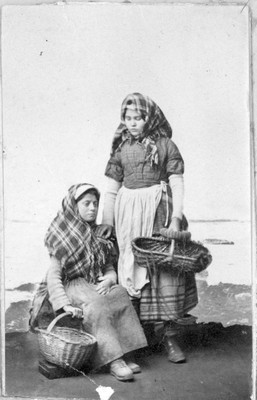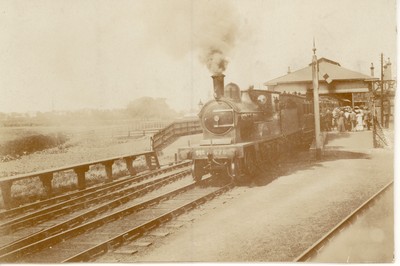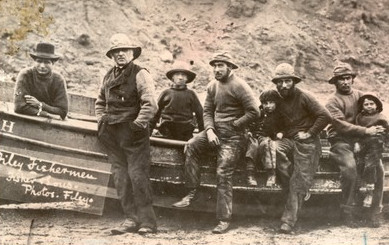
Menu:
The Market for Fish
Although Filey did
not have a rail link until 1846, a market for fish from the locality
had been established in Manchester as early as 1842. The Flamborough
Head and Filey Bay Fishing Company opened a shop near the site of
Victoria Station, although the station itself was not completed until 1844.
Contemporary accounts describe the process of getting fresh fish to
market in Manchester. The fish was landed on the afternoon of one
day and transported to Hull by carts for 36 miles. The catch from
both Filey and Flamborough were then loaded on to the early train to
arrive in Manchester before 6am.
The catch was on sale within 24 hours of leaving the water.
The company's shop was opened in the afternoon of Saturday with a supply of nineteen baskets with 12 stone of fish in each, a total haul of 3,192 lbs of fish. The fish was sold at very low prices, much lower than elsewhere in Manchester, causing crowds to gather in sufficient number to block the pathway on Victoria Bridge. The first day's stock sold out in under two hours.
Fish from the Yorkshire coast, especially cod was of much higher quality that any caught on the West coast and large number of Manchester's poor were able to eat nutritious food at very low prices at a time when many were on the brink of starvation. Many women waited for four or five hours for the shop to open on its third day of trading.
The selling of fish in Manchester then concentrated on the area known as The Shambles and in 1856 a specialist covered fish market was opened in the same area on Victoria street, known as Victoria Market.

The Filey Fishing Company is not listed after 1845 and is missing from the directories from 1850. It appears to have lasted for about a year. Others did continue to trade in Manchester, in particular with the connection of Filey to the rail network in 1846. Fish transported to major markets by rail undoubtedly included catches from Filey and Flamborough. These catches played a major part in making fresh fish affordable to the masses.

A train leaves Filey -late 19th century . Copyright © Crimlisk - Fisher Archive
The company's shop was opened in the afternoon of Saturday with a supply of nineteen baskets with 12 stone of fish in each, a total haul of 3,192 lbs of fish. The fish was sold at very low prices, much lower than elsewhere in Manchester, causing crowds to gather in sufficient number to block the pathway on Victoria Bridge. The first day's stock sold out in under two hours.
Fish from the Yorkshire coast, especially cod was of much higher quality that any caught on the West coast and large number of Manchester's poor were able to eat nutritious food at very low prices at a time when many were on the brink of starvation. Many women waited for four or five hours for the shop to open on its third day of trading.
The selling of fish in Manchester then concentrated on the area known as The Shambles and in 1856 a specialist covered fish market was opened in the same area on Victoria street, known as Victoria Market.

Bait girls about 1890 Copyright © Crimlisk - Fisher Archive
The Filey Fishing Company is not listed after 1845 and is missing from the directories from 1850. It appears to have lasted for about a year. Others did continue to trade in Manchester, in particular with the connection of Filey to the rail network in 1846. Fish transported to major markets by rail undoubtedly included catches from Filey and Flamborough. These catches played a major part in making fresh fish affordable to the masses.

A train leaves Filey -late 19th century . Copyright © Crimlisk - Fisher Archive
The second half of the nineteenth century saw unprecedented growth but with gross inequality. Nutritional standards for the great mass of the population only improved gradually and the growth of the rail network played a large part in improving the diet of the poor. In Filey itself by the mid to late nineteenth century, inequality was blatant. The insanitary squalor of the Old Town was in stark contrast to the elegant town houses, Hotels and apartments of the New Town. Improvements in the condition of the poor only began after the Public Health Act of 1848 and the Education Act of 1870.

A Filey Fishing family- the Robinsons 19th century . Copyright © Crimlisk - Fisher Archive
In Filey the importance of the fishing industry began to be reduced by the growth in another endeavour dependent on the growth of the transport, not of goods, but of people, with tourism becoming a major sector for employment.
The steep decline of the British fishing industry in the second half of the twentieth century took place due to complex interrelated factors, not least the decline in the North Sea fish population, which is still yet to recover. The market fish is now an international one with sought after crustaceans landed at Bridlington for example, being flown out to mainland Europe and beyond, in stark contrast to Filey's foothold in the markets of Manchester in the nineteenth century.
© Crimlisk - Fisher Archive. Written by B Mulrine and S Pinder.